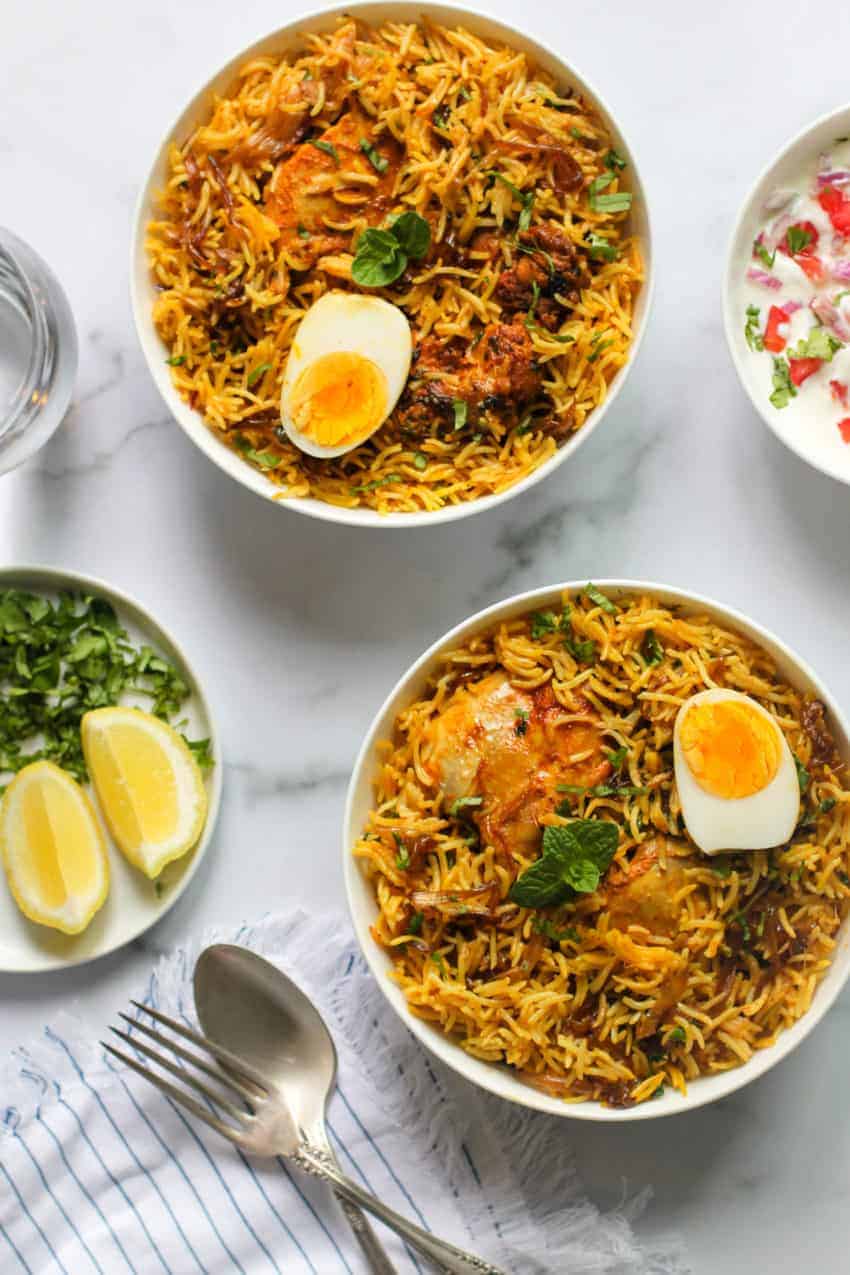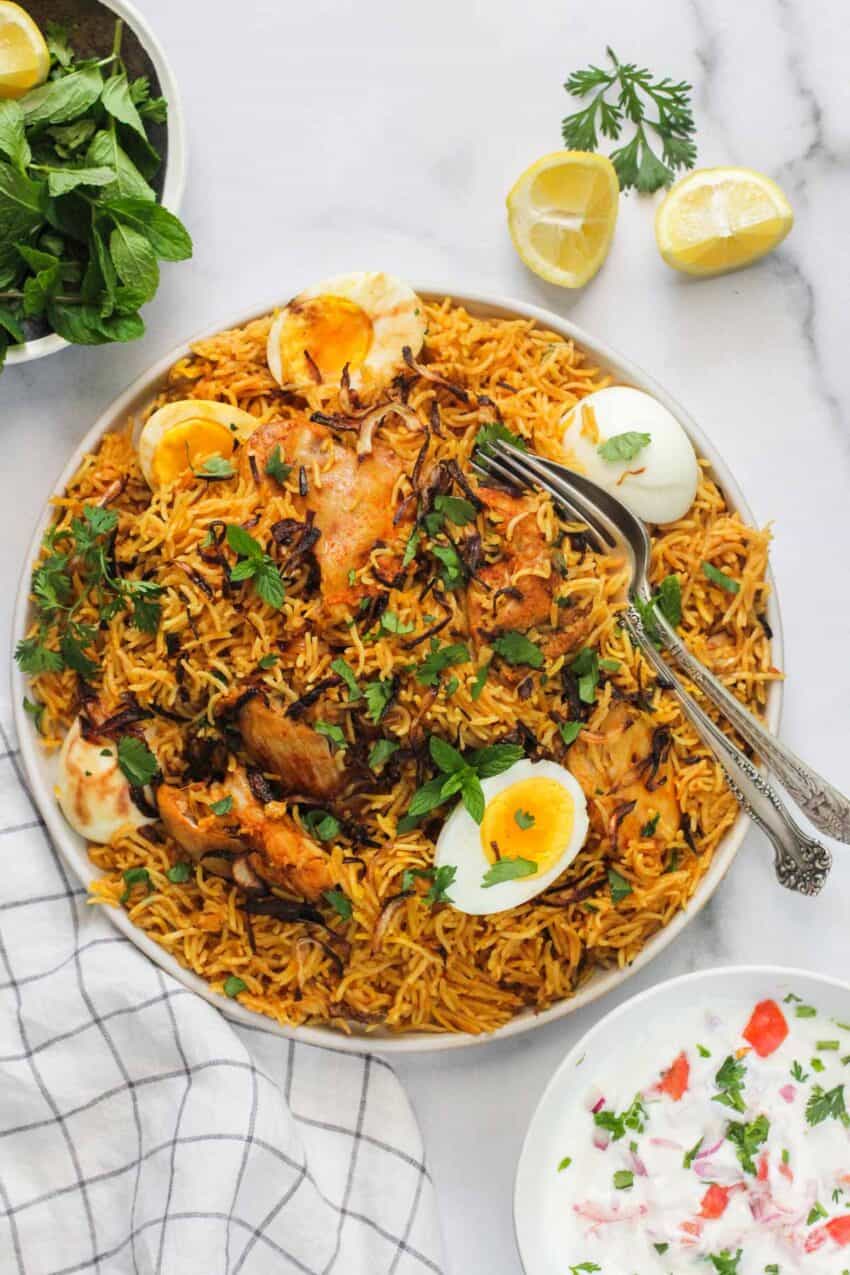This article is about the dum biryani recipe dish. For the 2020 film, see Biriyaani. Not to be confused with Isfahan Beryani. This article contains Hindi, Urdu, Arabic, and Persian text.
Biryani is one of the most popular dishes in South Asia, as well as among the diaspora from the region. It has gained popularity in South India, and is also prepared in other parts of the world such as Iraqi Kurdistan. Persian was used as an official language in different parts of medieval India by various Islamic dynasties. The exact origin of the dish is uncertain. Another theory claims that the dish was prepared in India before the first Mughal emperor Babur conquered India.
According to Pratibha Karan, who wrote the book Biryani, biryani is of South Indian origin, derived from pilaf varieties brought to the Indian subcontinent by Arab traders. She speculates that the pulao was an army dish in medieval India. Armies would prepare a one-pot dish of rice with whichever meat was available. According to Vishwanath Shenoy, the owner of a biryani restaurant chain in India, one branch of biryani comes from the Mughals, while another was brought by the Arab traders to Malabar in South India. There are various apocryphal stories dating the invention to Shah Jahan’s time but Rana Safvi, the distinguished historian, says she could only find a recipe from the later Mughal period, from Bahadur Shah Zafar’s time.

Other historians who have gone through texts say that the first references to biryani only appear around the 18th century. Pilaf or pulao, as it is known in the Indian subcontinent, is another mixed rice dish popular in the cuisines of the Indian subcontinent, Central Asia, and Middle Eastern cuisine. According to Delhi-based historian Sohail Hashmi, pulao tends to be plainer than biryani, and consists of meat or vegetables cooked with rice with the bottom layered with potatoes or onions. Biryani is the primary dish in a meal, while the pulao is usually a secondary accompaniment to a larger meal. Biryanis have more complex and stronger spices compared to pulao. The British-era author Abdul Halim Sharar mentions the following as their primary difference: biryani has a stronger taste of curried rice due to a greater amount of spices.
Ingredients for biryani vary according to the region and the type of meat and vegetables used. As is common in dishes of the Indian subcontinent, vegetables are sometimes also used when preparing biryani. A yoghurt-based marinade at the bottom of the cooking pot provides additional flavor and moisture. The lid is not opened until the dish is ready to serve. If direct heat is used, there is a risk that the food layer in contact with the vessel bottom may get burned while the interior’s contents are still raw. This risk is minimized by sustained baking with moderate heat, or very slow cooking on low direct heat. This approach, however, increases cooking time considerably.

One method is cooking the dish “blind”, with the cooking vessel sealed, so one cannot monitor cooking progress—it takes understanding of the raw foods used, the heat required to cook those raw foods, and how the climate can affect the cooking process. Hence making kacchi biryani requires a used to experience. Hyderabadi vegetable biryani served in Tampa, U. There are many types of biryani, whose names are often based on their region of origin. For example, Sindhi biryani developed in the Sindh region of what is now Pakistan, and Hyderabadi biryani developed in the city of Hyderabad in South India. Vaniyambadi biryani is a variety cooked in the neighboring towns of Ambur and Vaniyambadi in the Tirupattur district of the northeastern part of Tamil Nadu, which has a high Muslim population.
It has a distinctive aroma and is considered light on the stomach. The usage of spice is moderate and curd is used as a gravy base. It also has a higher ratio of meat to rice. Beef biryani, as the name implies, uses beef as the meat. In Hyderabad, it is famous as Kalyani biryani, in which buffalo or cow meat is used.
This meal was started after the Kalyani Nawabs of Bidar came to Hyderabad sometime in the 18th century. This is an integral part of the Navayath cuisine and a specialty of Bhatkal, a coastal town in Karnataka. Its origins are traced to the Persian traders who left behind not only biryani but a variation of kababs and Indian breads. Though similar to those in Thalassery, this biryani differs with lingering after-notes of mashed onions laced with garlic.
A few chilies and spices littered with curry leaves lends a unique flavour to Bhatkal biryani. Bohri biryani, prepared by the Bohris is flavoured with many tomatoes. Chettinad biryani is famous in the Indian state of Tamil Nadu. It is made of jeeraka samba rice, and smells of spices and ghee.
